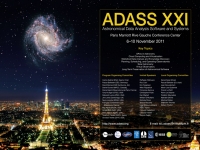Gijs Verdoes Kleijn (Target / OmegaCEN / Kapteyn Astronomical Institute, Groningen University), J. de Jong (Leiden Observatory), E. Valentijn (Target), K. Kuijken (Leiden Observatory), J. Bout (Target), D. Boxhoorn (Target), E. Helmich (Target), J. Mcfarland (Target), G. Sikkema (Target). For the KiDS and Astro-WISE teams.
Abstract
The Kilo Degree Survey (KiDS) is a 1500 square degree optical Public Survey. It is the largest of ESO’s Public Surveys using the recently commissioned OmegaCAM wide-field imager on the VLT Survey Telescope (VST), Paranal Observatory. A suite of data products will be delivered to ESO and the community by the KiDS survey team. Spread over Europe, the KiDS team needs a data handling system to collaborate efficiently for their survey operations and data analysis. Using the Astro-WISE system the team can share, calibrate, archive, and analyze all survey data in a flexible, distributed, and interactive manner.
The end point is the starting point for survey handling in Astro-WISE. End-targets are specified by the user: e.g., photometric redshifts or morphometry for a survey tile, or multi-colour catalogs or calibrated survey tiles. These end-targets are created by automatic pulling of the information flow (metadata, pixeldata) through processing levels of intermediate targets, creating those 'on-the-fly' as needed. This pulling can reach many processing levels back. It ultimately reaches the situation that end targets are created in a single handling command with only raw data as starting point. All bits of this information flow can be shared/published to private, team or public level. The survey operations are performed using webservices and command-line interfaces.
This poster gives an overview of KiDS and its survey operations in Astro-WISE. It describes how the team tackles key survey challenges using Astro-WISE: alternative calibration methods and pipelines; optimizing system vs interactive quality control; maximum survey product precision and accuracy from long-term instrument monitoring.Poster in PDF format
Paper ID: P157
Poster Instructions
|

